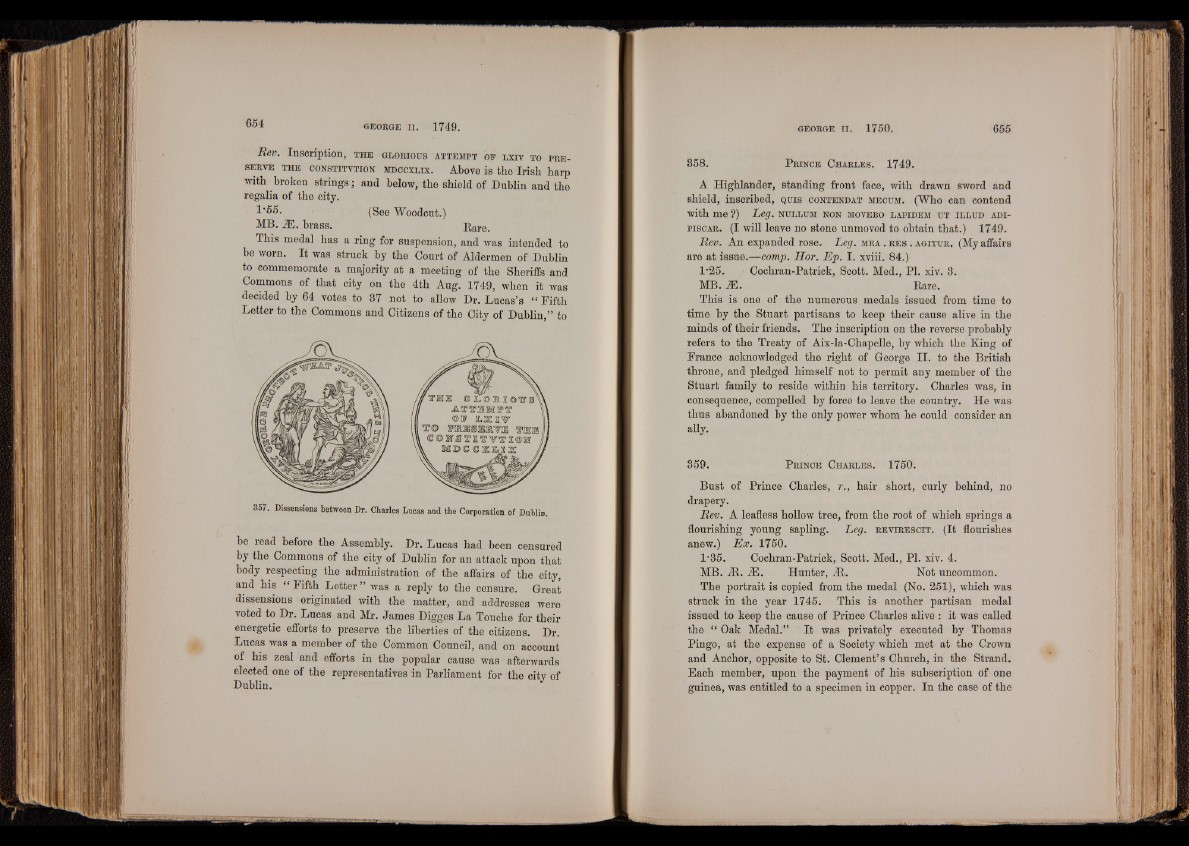
Rev. Inscription, t h e g l o r io u s a t t em p t o f lx iv to p r e s
e r v e t h e c o n s t it v t io n MDOCXLix. Above is the Irish harp
with broken strings; and below, the shield of Dublin and the
regalia of the city.
1*65. (See Woodcut.)
MB. M. hrass. Bare.
This medal has a ring for suspension, and was intended to
be worn. It was struck by the Court of Aldermen of Dublin
to commemorate a majority at a meeting of the Sheriffs and
Commons of that city on the 4th Aug. 1749, when it was
decided by 64 votes to 87 not to allow Dr. Lucas’s “ Fifth
Letter to the Commons and Citizens of the City of Dublin,” to
357. Dissensions between Dr. Charles Lucas and the Corporation of Dublin.
be read before the Assembly. Dr. Lucas had been censured
by the Commons of the city of Dublin for an attack upon that
body respecting the administration of the affairs of the city,
and his “ lifth Letter” was a reply to the censure. Great
dissensions originated with the matter, and addresses were
voted to Dr. Lucas and Mr. James Digges La Touche for their
energetic efforts to preserve the liberties of the citizens. Dr.
Lucas was a member of the Common Council, and on account
of his zeal and efforts in the popular cause was afterwards
elected one of the representatives in Parliament for the citv of
Dublin.
858. P r in c e C h a r l e s . 1749.
A Highlander, standing front face, with drawn sword and
shield, inscribed, q u is co n t en d a t m ec um . (Who can contend
with me ?) Leg. n u l l um non movebo l a p id em u t il l u d a d i-
p is c a r . (I will leave no stone unmoved to obtain that.) 1749.
Rev. An expanded rose. Leg. m ea . r e s . a g it u r . (My affairs
are at issue.—comp. Hor. Ep. I. xviii. 84.)
1*25. Cochran-Patrick, Scott. Med., PI. xiv. 8.
MB. JE. Bare.
This is one of the numerous medals issued from time to
time by the Stuart partisans to keep their cause alive in the
minds of their friends. The inscription on the reverse probably
refers to the Treaty of Aix-la-Chapelle, by which the King of
France acknowledged the right of George II. to the British
throne, and pledged himself not to permit any member of the
Stuart family to reside within his territory. Charles was, in
consequence, compelled by force to leave the country. He was
thus abandoned by the only power whom he could consider an
ally.
859. P r in c e C h a r l e s . 1750.
Bust of Prince Charles, r., hair short, curly behind, no
drapery.
Rev. A leafless hollow tree, from the root of which springs a
flourishing young sapling. Leg. r e v ir e s c it . (It flourishes
anew.) Ex. 1750.
1‘35. Cochran-Patrick, Scott. Med., PI. xiv. 4.
MB. At. 2E. Hunter, JR. Not uncommon.
The portrait is copied from the medal (No. 251), which was
struck in the year 1745. This is another partisan medal
issued to keep the cause of Prince Charles alive : it was called
the “ Oak Medal.” It was privately executed by Thomas
Pingo, at the expense of a Society which met at the Crown
and Anchor, opposite to St. Clement’s Church, in the Strand.
Each member, upon the payment of his subscription of one
guinea, was entitled to a specimen in copper. In the case of the